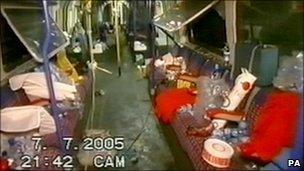7 July inquest: Tube driver recalls 'almighty bang'
- Published

Passengers became hysterical after the blast, one survivor said
A Tube train driver has told an inquest that all he could see after a bomb exploded on his train on 7 July 2005 was a "sea of blackened faces".
Piccadilly Line operator Thomas Nairn was the first to enter the carriage after hearing an "almighty bang".
Twenty-six people died in the attack by suicide bomber Germaine Lindsay as the Tube travelled between King's Cross and Russell Square stations.
Earlier, a survivor described the pandemonium after the blast.
Fifty-two people were killed by suicide bombers on three Tube trains and a bus.
Mr Nairn told the inquest he put the emergency brakes on after hearing an "almighty, metallic bang" on board his train, which was carrying between 1,000 and 1,500 passengers.
Almost immediately he tried to make a Mayday call on his radio before speaking to passengers over the public address system, but neither were working, he said.
He then entered the first carriage and shone a torch around.
"I could see a sea of faces. I could see they were blackened and their hair was kind of on end and frizzy," he told the hearing.
He then took measures to check the track was not live.
Another driver, Raymond Wright, had been sitting alongside Mr Nairn in the driver's cab, catching a ride back to his depot when the bomb went off.
Mr Wright said he led the walking wounded and some without injuries along the track towards Russell Square.
Meanwhile, Mr Nairn stayed with passengers with more serious injuries.
Hand held
Coroner Lady Justice Hallett told Mr Nairn he had done "everything according to the book".
Earlier Paul Mitchell, who survived the bombing, told the inquest the carriage had been crammed when "an extremely loud pop and a very bright yellow light" went off.
"It all happened so quickly. There was complete and utter pandemonium. There were people screaming. I thought my hair was on fire," he said.
Mr Mitchell said: "I was thrown to the ground with such force."
Later, a sanitary towel was passed along the carriage which was applied to Mr Mitchell's leg to help stop the bleeding, the coroner was told.
Fellow passenger Julie Gruen provided her coat and a tourniquet was formed.
"I had lost a lot of blood, a lot of tissue, a lot of muscle and yes, it was essential.
"It undoubtedly saved my leg," Mr Mitchell said of the tourniquet.
'Horror film'
Ms Gruen helped tend to Mr Mitchell's injuries and gave reassurance to others in the aftermath.
She said she recalled a huge fireball coming towards her as though in a scene from "some kind of horror film".
She said she was aware "something horrendous" had happened.
In the five seconds or so after the blast, the carriage fell silent, but then people became hysterical, with one woman screaming: "We're all going to die," the inquest heard.
Ms Gruen said she turned to Mr Mitchell in the dark and tied her coat around his leg, feeling her way, and tried to reassure him.
Meanwhile another man, with serious facial injuries, was trying to comfort her.
Lady Justice Hallett thanked Ms Gruen for helping her fellow passengers.
"It seems as if your prompt action contributed to saving his (Mr Mitchell's) leg, if not, contributed to saving his life," she said.
'Presence of mind'
Paul Glennerster, from High Wycombe, later recalled how his clothes were blown off his back and his leg was damaged.
He told the court he feared if they stayed underground no-one would come for them, so he "picked up (his) leg and hopped" onto the tracks.
Sometime later, four police officers arrived and carried him on a stretcher along the tracks, while the Tube driver held his hand and talked to him.
He was taken to St Thomas' Hospital with very serious injuries and has since undergone considerable surgery and treatment, the court heard.
Lady Justice Hallett commended Mr Glennerster for his "amazing presence of mind" to get out of the carriage and go for help.
Also on Tuesday, two Appeal Court judges sitting in the High Court gave their reasons for rejecting a bid by MI5 to have secret evidence heard in private.
Home Secretary Theresa May had sought to have victims' relatives excluded from hearings relating to MI5's knowledge of the bombers before the attacks.
Lady Justice Hallett rejected the bid on 3 November, and the Appeal Court judges upheld the ruling last week.
Lord Justice Maurice Kay and Lord Justice Stanley Burnton agreed with her interpretation of Rule 17 of the Coroners Rules 1984, which allows a coroner to exclude the public from hearings in the interests of national security.
But they said this does not include "interested persons" who are legally entitled to be represented at an inquest, such as the relatives of the 52 victims of the 7/7 attacks.
Lord Justice Stanley Burnton said: "The contention that the coroner has an implied power to hold secret sessions when she considers that it would be in the interests of national security to do so is hopeless."